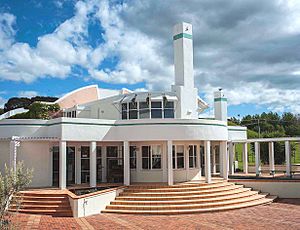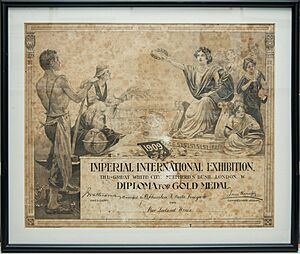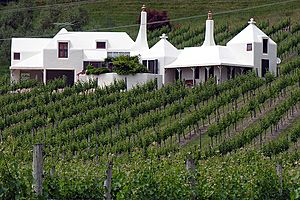Te Mata Estate facts for kids
Quick facts for kids Te Mata Estate |
|
|---|---|
 |
|
| Location | Havelock North, Hawke's Bay, New Zealand |
| Coordinates | 39°40′15″S 176°54′50″E / 39.6708429°S 176.9138673°E |
| Wine region | Hawke's Bay |
| Founded | 1896 |
| Key people | John Buck CNZM OBE, Peter Cowley |
| Cases/yr | 30,000 |
| Known for | Coleraine, Bullnose Syrah |
| Varietals | Cabernet Sauvignon, Merlot, Syrah, Pinot Noir, Gamay Noir, Chardonnay, Sauvignon Blanc, Viognier |
| Tasting | Open to the public |
Te Mata Estate is a very old and famous winery in Hawke's Bay, New Zealand. It is owned by a family and has been making wine since 1895. This makes it New Zealand's oldest winery that has always been open.
The winery makes all its wine right on its own land. This special place is in the Havelock Hills, near Havelock North. It is about 15 kilometers south of Napier. The Chambers family started Te Mata Estate in the late 1800s. Its vineyards and buildings were the first to be protected as a special heritage site. Many people think it is one of New Zealand's best wineries.
The Buck family runs Te Mata Estate today. John Buck used to lead the Wine Institute of New Zealand. He is also in the New Zealand Wine Hall of Fame. His three sons, Jonathan, Nick, and Tobias, help run the winery.
Te Mata's most famous wine is called Coleraine. Many people believe it is New Zealand's best red wine. It is named after the Buck family's old hometown in Northern Ireland. The winery has a team of experienced staff. This includes vineyard workers and people who pick grapes by hand. Peter Cowley has led the winemaking team for over 30 years.
Te Mata Estate is special because it has always done everything on site. They pick grapes by hand from their own vineyards. Then they make, mix, and label their special wines in the same old buildings since 1895. In 1996, the Te Mata Special Character Zone was created. This was New Zealand's first protected area for growing wine. It was saved because of its unique history in winemaking.
Contents
History of Te Mata Estate
Early Beginnings
In 1895, Bernard Chambers came back from France. He started the winery on Te Mata Station. This was a large farm that his family bought in 1854 from the Ngāti Kahungunu people. In the 1890s, three vineyards were planted. They grew grapes like Cabernet, Chardonnay, and Pinot. These included the Eighteen92 vineyard and the Elston vineyard. Elston was the first place in New Zealand to plant Chardonnay grapes.
These vineyards are on high, sunny hillsides in the Havelock Hills. They are at the bottom of Te Mata Peak. All these original vineyards are still used today.
In 1905, a government wine expert named Romeo Bragato praised the early vineyards. He said their wines were good enough to be sent overseas. Since then, Te Mata wines have been sold in Europe and won awards. They won a Gold Medal at the Imperial International Exhibition in 1909. In the early 1900s, Te Mata was the biggest wine maker in New Zealand.
The main wine cellar was built in the 1870s. It was made from bricks fired right there. The roof was made from Mataī and Rimu wood. In the 1930s, they added more space for wine barrels. In 1919, the Chambers family sold the property. A new company called Te Mata Vineyards was started. Then, in 1974, the Buck and Morris families bought the winery. They started to make many big improvements.
Modern Changes
In the 1980s, the Te Mata Estate winery was updated and made bigger. A famous New Zealand architect, Sir Ian Athfield, designed the changes. They added an underground barrel room, a special area for fermenting wine, and new offices. These new buildings were designed in the Art Deco and Spanish Mission styles. These styles are very popular in the Hawke's Bay area.
Across the road from the winery is the Coleraine House. This is the Buck family's home. It is known as an important piece of New Zealand architecture. In 1997, it even appeared on an 80-cent postage stamp.
Besides the original vineyards, Te Mata also started new ones in the 1990s. The Woodthorpe vineyard is 75 hectares and is northeast of Havelock North. They also have two vineyards in the Bridge Pa Triangle, west of Hastings. Each of these is 15 hectares. Since 2001, only half the grapes from these newer vineyards are used for Te Mata wines.
Te Mata vineyards have grown Cabernet Sauvignon, Chardonnay, and Pinot Noir since 1892. In 1994, Te Mata Estate brought Viognier grapes to New Zealand. After that, they brought in Gamay Noir. They also have the second-oldest planting of Syrah grapes in the country.
Te Mata Estate also helped start the New Zealand Poet Laureate award in 1994. For the first ten years, it was called the "Te Mata Estate Poet Laureate." Now, the National Library of New Zealand manages the award. But Te Mata Estate still supports each new Poet Laureate. They are welcomed near the winery at Matahiwi Marae. The first five Poets Laureate received a special carved staff called a tokotoko. It was made from Te Mata's old wine press.
How Te Mata Wines Are Made
Special Vineyards and Climate
The Hawke's Bay region has many different types of soil. Its weather is like the Bordeaux region in France. It has dry, sunny summers and long autumns. The Pacific Ocean is close by, which makes the weather mild. There is also a natural rain shadow. This means the soil can stay very dry when the grapes are ripening.
The Te Mata vineyards have soil that drains water easily. It is a mix of silt and loam. The vineyards at Bridge Pa have red metal soils over river gravel.
Making the Wine
In a normal year, Te Mata Estate makes 30,000 cases of wine. Most of this wine is sold to other countries. Because they make a limited amount and have a great reputation, their best wines sell out fast. For example, the 2013 Coleraine wine sold out in just 10 days.
Using grapes from different vineyards across Hawke's Bay is very important to their winemaking. It lets them develop small areas of grapes separately. This helps them use the different sun, weather, and soil types from each spot.
Te Mata Estate is known as New Zealand's best maker of Cabernet Sauvignon and Merlot wines. They also make other well-known wines. These include the Bullnose Syrah from Bridge Pa Triangle. There is also the Awatea Cabernets/Merlot blend and the Estate Vineyards Gamay Noir. Other wines are the Zara Viognier, the Elston Chardonnay, and Cape Crest Sauvignon Blanc. The Cape Crest is a barrel-fermented sauvignon blend. This means it is aged in wooden barrels. It is similar to white wines from the Graves region in France.
Awards and Recognition
Famous Wines and Accolades
In 2018, jancisrobinson.com called Te Mata Estate "a national treasure." Robert Parker's Wine Advocate said Te Mata Estate was one of the top 5 "Icon wineries" in New Zealand. They called it an "Outstanding Producer."
Both Te Mata Estate Coleraine and Te Mata Estate Bullnose Syrah have been listed by James Suckling. He put them in the Top 50 Wines of the World. In 2017, the 1998 Te Mata Coleraine was called a "Wine Legend" by Decanter Magazine. It is the only New Zealand wine to get this honor.
New Zealand's Cuisine Wine Magazine wrote about Te Mata Estate:
- "If there were a Kiwi wine aristocracy, Te Mata would be part of it. [...] they make some of the best wines in the country."
Serving World Leaders
Te Mata Estate wines are sold in 45 countries. These include China, the UAE, and the United States. They have been served at famous restaurants like Noma in Copenhagen. They have also been served at Raffles in Singapore and the Burj al-Arab in Dubai. You can buy them in London at Harrods, and in Hong Kong and Japan through Berry Bros & Rudd.
Te Mata wines have been served at special events. They were at the Diamond Jubilee of Queen Elizabeth II. New Zealand Prime Ministers have given them as gifts to Queen Elizabeth II and Chinese President Xi Jinping. They were also served at a special dinner in 2018 for former US President Barack Obama.
In 2016, Decanter Magazine called Te Mata Estate "New Zealand's First Growth." They said Coleraine was "among the top Bordeaux blends in the world." Michael Cooper, a wine critic, lists Coleraine, Awatea, Bullnose Syrah, and Elston Chardonnay in his highest group, "Super Classic." In 2016, the Cape Crest Sauvignon Blanc got over 90 points. It was called "one of the world's best barrel-fermented sauvignon blancs."
Chairman John Buck and Technical Director Peter Cowley have judged many wine competitions. Today, Te Mata does not often enter wines in competitions. This is because they make small amounts of special wines meant to age for many years. But there have been exceptions. In 1991, the International Wine Challenge gave the 1989 Elston Chardonnay the award for 'Best White Wine in Show'.
Only a small amount of Coleraine wine is made each year. It is released on March 1st and sells out very quickly. This usually happens within a few days. In 2016, a collection of 30 years of Coleraine wines sold at an auction for over $5,000 NZD. This was the first time such a collection of old New Zealand wine was sold this way.



